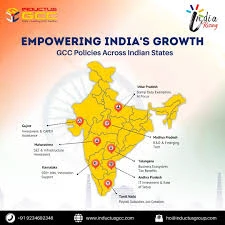Today's interconnected business world, companies everywhere are looking for smart ways to grow, innovate, and get ahead. One powerful strategy that has truly reshaped the global landscape is setting up an Offshore Development Center (ODC). For businesses aiming for efficiency, specialized talent, and continuous innovation, an ODC in India stands out as a clear leader.
At Inductus GCC, we've seen first hand how an ODC can transform a company's capabilities. It's far more than just a way to save money; it's about building a strategic powerhouse that acts as a seamless extension of your core team, deeply integrated with your company's vision and goals.
Let's dive into why India is the go-to destination for ODCs and how your business can leverage this strategic advantage.

What Exactly is an Offshore Development Center (ODC)?
Think of an ODC as your dedicated, highly skilled team located in a different country, often where operational costs are lower. Unlike simply outsourcing a project to a third-party vendor who might be working for many clients, an ODC team works solely for you. They breathe your company culture, understand your specific processes, and are committed to your long-term success, almost as if they were sitting in the office next door.
It's about having your own specialized unit abroad, allowing you to scale your development, engineering, or support functions with greater control and alignment.
Why India is the Undisputed Leader for ODCs
For decades, India has been the top choice for companies looking to establish ODCs. This isn't by chance; it's due to a unique blend of advantages that make India genuinely unparalleled.
1. A Deep Well of Diverse and Skilled Talent:
- Unmatched Scale: India graduates millions of engineers, IT professionals, and specialized domain experts every year. This means you have access to one of the largest talent pools in the world.
- Cutting-Edge Expertise: Indian professionals aren't just plentiful; they're highly proficient in a vast array of technologies. From traditional software development and quality assurance to the latest advancements in Artificial Intelligence (AI), Machine Learning (ML), Cloud Computing, Cybersecurity, Data Science, and IoT – the skills are readily available.
- Global Readiness: Many Indian IT professionals are trained to global standards, possess strong analytical and problem-solving skills, and are quick to adopt new technologies.
2. Significant Cost Advantages Without Compromising Quality:
- Substantial Savings: This is often the initial draw. The cost of highly skilled labor, real estate, and overall infrastructure in India can be significantly lower (often 30-70% less) compared to countries in North America or Western Europe. These savings allow you to invest more in innovation, research and development, or market expansion.
- Value for Money: The lower cost does not mean lower quality. India's ODCs are renowned for delivering high-quality work, often exceeding expectations due to a strong work ethic and focus on results.
3. The "Follow-the-Sun" Advantage for 24/7 Productivity:
- India's strategic time zone is a huge benefit. As your teams in the US or Europe conclude their workday, your ODC team in India can pick up where they left off, ensuring continuous project progression. This "follow-the-sun" model drastically accelerates development cycles, reduces time-to-market, and helps meet aggressive deadlines, providing a true 24/7 operational capability.
4. Robust IT Infrastructure and a Dynamic Tech Ecosystem:
- India has invested heavily in its digital backbone. Modern IT parks, Special Economic Zones (SEZs), and reliable high-speed internet connectivity are widely available.
- The country's thriving tech ecosystem, buzzing with startups, established IT giants, and a strong culture of innovation, creates a supportive environment for technology-driven businesses. This ecosystem fosters skill development and provides a network of supporting services.
5. High English Proficiency and Smooth Communication:
- Communication is key to any successful collaboration. India has a large workforce proficient in English, particularly within the professional and technical sectors. This significantly minimizes language barriers, leading to clearer communication, fewer misunderstandings, and more efficient project execution.
6. Strong Government Support and Business-Friendly Policies:
- The Indian government actively promotes the IT and IT-enabled services (ITeS) sector. Various initiatives, tax incentives, subsidies, and streamlined regulatory processes make it very attractive and easier for foreign companies to set up and operate an ODC. This supportive environment reduces administrative burdens and accelerates establishment.

7. Proven Track Record and Scalability:
- Many of the world's leading multinational corporations have successfully run ODCs and Global Capability Centers (GCCs) in India for years, some for decades. This extensive and successful track record provides a strong foundation of confidence for new entrants.
- ODCs in India offer exceptional scalability. Whether you need to quickly ramp up a large team for a new project or scale down for specific phases, India's vast talent pool and flexible operational models allow for efficient adjustments to team size and composition.
8. Enhanced Control and Robust Intellectual Property (IP) Protection:
- Unlike traditional outsourcing, where you might have less direct control, an ODC model allows you to maintain high oversight over your development processes, team structure, and strategic direction.
- India's legal framework provides robust protection for intellectual property rights. When setting up an ODC, you can implement stringent security measures and contractual agreements to safeguard your sensitive data and proprietary information.

Your Roadmap to Setting Up an ODC in India
Establishing an ODC in India requires thoughtful planning. Here's a step-by-step guide to help you navigate the process successfully:
1. Clarify Your Vision: Define Objectives and Scope
- The "Why": What do you aim to achieve with your ODC? Is it to accelerate product development, establish a dedicated R&D arm, optimize specific business processes (like finance or cybersecurity), or build a core engineering team? A clear "why" guides all subsequent decisions.
- Functional Scope: Identify which specific functions or projects are best suited for your ODC. You might start with a focused area like a specific software module or a data analytics team, and then expand.
- Long-Term Strategy: How will this ODC evolve? Will it remain a development hub or transform into a full-fledged Global Capability Center (GCC) that drives strategic value and innovation for your global enterprise?
2. Strategic Location Selection within India
- India is vast, and different cities offer different strengths.
- Tier-1 Cities (e.g., Bangalore, Hyderabad, Pune, Gurugram, Chennai): These are established IT hubs with mature ecosystems, extensive talent, and advanced infrastructure. They offer immediate access to diverse skills but come with higher costs and more intense competition for talent.
- Tier-2 Cities (e.g., Jaipur, Coimbatore, Chandigarh, Indore, Bhubaneswar, Mysore): These emerging cities offer significant cost efficiencies, a loyal and growing talent pool, and rapidly improving infrastructure. They are becoming increasingly attractive for companies seeking a balance of cost, quality, and lower attrition.
- Key Evaluation Factors: Beyond cost, consider the availability of specific niche skills you need, local university ties, connectivity (airports, road networks), quality of life for employees, and any state-specific government incentives.
3. Choosing the Right ODC Engagement Model
- Dedicated ODC (Captive Model): This is where you fully own and operate your ODC, giving you maximum control over every aspect, from hiring to culture. Ideal for long-term strategic investments and full integration.
- Build-Operate-Transfer (BOT) Model: A popular choice for companies wanting a captive center eventually but needing a local partner (like Inductus GCC) to help set up and manage the initial operations, recruitment, and infrastructure. After an agreed period, the entire operation is transferred to you. This de-risks the initial setup.
- Partner-Operated (Managed ODC): You retain ownership of the IP, but a trusted partner manages the day-to-day operations, HR, and infrastructure. This offers operational ease without the full burden of direct setup.
- Hybrid Models: Often, companies combine elements, starting with a BOT or Managed ODC and transitioning to a fully captive model over time.
4. Navigating Legal and Regulatory Frameworks
- Entity Registration: Establish your legal entity in India. A Private Limited Company is often the most recommended structure for ODCs due to its limited liability and operational flexibility. Inductus GCC can guide you through these intricacies.
- Permits and Licenses: Secure all necessary local and national permits to operate. This includes business-specific licenses, and any environmental clearances if applicable.
- Taxation: Understand India's corporate tax structure, Goods and Services Tax (GST), and crucial transfer pricing regulations. Expert consultation is vital to ensure compliance and maximize any available tax benefits (especially if operating in an SEZ).
- Labor Laws: India has detailed labor laws. Familiarize yourself with regulations regarding working hours, employee benefits (Provident Fund, Employee State Insurance), and termination policies.
- Data Protection and IP: Comply with India's Digital Personal Data Protection Act (DPDPA), 2023, and international data protection standards like GDPR. Implement strong IP protection clauses in all contracts and ensure robust data security protocols.
5. Building and Nurturing Your Talent Pool
- Strategic Recruitment: Develop a robust plan to attract top talent. This includes partnerships with local universities, leveraging professional recruitment agencies, and building a strong employer brand that appeals to the local workforce.
- Competitive Packages: Research local salary benchmarks and offer competitive compensation, benefits (health insurance, provident fund), and opportunities for professional growth.
- Onboarding and Training: Develop a thorough onboarding program that integrates new hires into your company's global culture and processes. Invest in continuous upskilling and reskilling programs to keep your team at the forefront of technology.
- Retention Strategies: Focus on creating a positive work environment, offering clear career paths, and engaging employees through various initiatives to reduce attrition.
6. Establishing Robust Infrastructure and Technology
- Modern Office Space: Select a scalable office space that aligns with your headcount projections. Ensure it's in a well-connected area, ideally within an IT park, with amenities, reliable power backup, and physical security.
- Advanced IT Infrastructure: Implement high-speed, redundant internet connectivity. Deploy secure networks, cloud-based collaboration tools (like Microsoft Teams, Jira, Zoom), and the necessary hardware/software to facilitate seamless global operations.
- Cybersecurity First: Prioritize robust cybersecurity measures. This includes multi-factor authentication, data encryption, regular security audits, and ongoing employee training on data privacy and security best practices.
7. Effective Management and Seamless Communication
- Clear Governance: Establish clear reporting lines, decision-making processes, and accountability within the ODC and with your global headquarters.
- Collaboration Tools: Utilize industry-standard project management and communication tools to ensure transparency, track progress, and facilitate efficient collaboration across time zones.
- Regular Engagement: Schedule frequent virtual meetings (daily stand-ups, weekly reviews), feedback sessions, and performance dialogues to maintain alignment, build rapport, and address any challenges proactively.
- Cultural Bridging: Invest in cross-cultural training for both your onshore and ODC teams to foster mutual understanding and enhance collaboration.
Inductus GCC: Your Partner in Offshore Success
At Inductus GCC, we specialize in helping businesses like yours navigate the complexities of establishing and growing successful ODCs and Global Capability Centers in India. We understand that each company has unique needs and tailor our guidance to your specific strategic objectives. Our expertise ensures a smooth setup, optimal operations, and sustainable growth, allowing you to focus on your core business while we help you build a powerful offshore engine.We believe that a well-executed ODC strategy is not just about reducing costs; it's about unlocking new capabilities, accelerating innovation, and securing a competitive edge in the global market.
Conclusion
The decision to set up an Offshore Development Center in India is a strategic move that can fundamentally reshape your business for the better. By leveraging India's unparalleled talent pool, cost advantages, robust infrastructure, and supportive ecosystem, you can create a highly efficient, scalable, and innovative extension of your global operations.
This isn't merely about outsourcing tasks; it's about building a dedicated, integrated team that drives value, accelerates your time-to-market, and future-proofs your business. As the global economy continues to evolve, an ODC in India stands as a testament to strategic foresight, positioning your organization at the forefront of innovation and global leadership.


